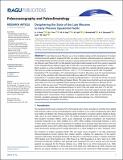Deciphering the state of the late Miocene to early Pliocene equatorial Pacific
Abstract
The late Miocene-early Pliocene was a time of global cooling and the development of modern meridional thermal gradients. Equatorial Pacific sea surface conditions potentially played an important role in this global climate transition, but their evolution is poorly understood. Here, we present the first continuous late Miocene-early Pliocene (8.0-4.4 Ma) planktic foraminiferal stable isotope records from eastern equatorial Pacific Integrated Ocean Drilling Program Site U1338, with a new astrochronology spanning 8.0-3.5 Ma. Mg/Ca analyses on surface dwelling foraminifera Trilobatus sacculifer from carefully selected samples suggest mean sea-surface-temperatures (SSTs) are ~27.8±1.1°C (1σ) between 6.4-5.5 Ma. The planktic foraminiferal δ18O record implies a 2°C cooling between 7.2-6.1 Ma and an up to 3°C warming between 6.1-4.4 Ma, consistent with observed tropical alkenone paleo-SSTs. Diverging fine-fraction-to-foraminiferal δ13C gradients likely suggest increased upwelling from 7.1-6.0 and 5.8-4.6 Ma, concurrent with the globally recognized late Miocene Biogenic Bloom. This study shows that both warm and asymmetric mean states occurred in the equatorial Pacific during the late Miocene-early Pliocene. Between 8.0-6.5 and 5.2-4.4 Ma, low east-west δ18O and SST gradients and generally warm conditions prevailed. However, an asymmetric mean climate state developed between 6.5-5.7 Ma, with larger east-west δ18O and SST gradients and eastern equatorial Pacific cooling. The asymmetric mean state suggests stronger trade winds developed, driven by increased meridional thermal gradients associated with global cooling and declining atmospheric pCO2 concentrations. These oscillations in equatorial Pacific mean state are reinforced by Antarctic cryosphere expansion and related changes in oceanic gateways (e.g., Central American Seaway/Indonesian Throughflow restriction).
Citation
Drury , A J , Lee , G P , Gray , W R , Lyle , M , Westerhold , T , Shevenell , A E & John , C M 2018 , ' Deciphering the state of the late Miocene to early Pliocene equatorial Pacific ' , Paleoceanography and Paleoclimatology , vol. Early View . https://doi.org/10.1002/2017PA003245
Publication
Paleoceanography and Paleoclimatology
Status
Peer reviewed
ISSN
2572-4525Type
Journal article
Description
A.J. Drury was funded by a Janet Watson studentship from Imperial College London.Collections
Items in the St Andrews Research Repository are protected by copyright, with all rights reserved, unless otherwise indicated.

